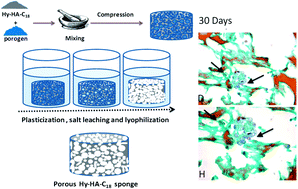Construction and evaluation of sponge scaffolds from hyaluronic acid derivatives for potential cartilage regeneration
Abstract
A two or one pot synthesis has been used for the reaction of hyaluronic acid (HA) with octadecylamine (C18) and hydrazine (Hy). In both cases, the chemical derivatization involved primary hydroxyl groups of hyaluronic acid and not its carboxyl groups, whose presence is important for receptor interaction. In this way, Hy-HA-C18 derivatives have been obtained with appropriate hydrophobic and hydrophilic character. Their ability to form homogeneous physical hydrogels has been evaluated as well as the possibility to obtain porous sponges through salt leaching technology. Sponges showing the highest porosity, potentially compatible with cell entrapment, have been characterized with regard to their physicochemical and biological properties. Swelling ability under simulated physiological conditions and stability in the absence or in the presence of hyaluronidase have been investigated. Bovine chondrocytes were viable in Hy-HA-C18 sponges as determined with MTS assay and were able to produce collagen and glycosaminoglycans, as assessed by using Masson's trichrome and Alcian blue, respectively. Finally, in vivo degradation of Hy-HA-C18 sponges has been confirmed after subcutaneous implantation in mice until 6 weeks.


 Please wait while we load your content...
Please wait while we load your content...